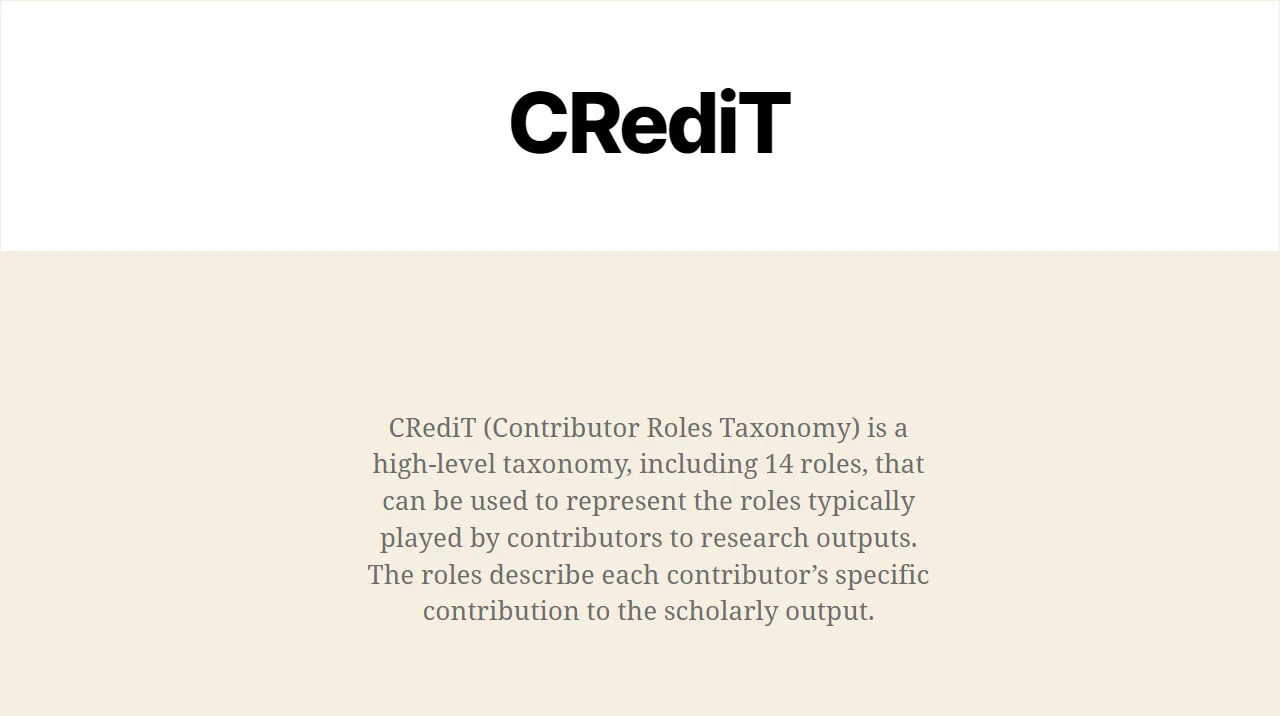Authors' Update - keeping journal authors in touch with industry developments, support and training

Leider unterstützen wir Ihren Browser nicht vollständig. Wenn Sie die Möglichkeit dazu haben, nehmen Sie bitte ein Upgrade auf eine neuere Version vor oder verwenden Sie Mozilla Firefox, Microsoft Edge, Google Chrome oder Safari 14 bzw. eine neuere Version. Wenn Sie nicht dazu in der Lage sind und Unterstützung benötigen, senden Sie uns bitte Ihr Feedback.
Wir würden uns über Ihr Feedback zu diesen neuen Seiten freuen.Sagen Sie uns, was Sie denken
16. Mai 2023
Von Zoë Genova

In a landscape of increasingly collaborative research and multi-authorship, standard author lists at the top of an article don’t always adequately convey the diverse contributions of different individuals. When trying to secure funding or move up the career ladder, being listed as an “author” might not go far enough to provide the deserved or required recognition for one’s work. That’s where “Contributor Roles Taxonomy” (CRediT) comes in. CRediT aims to reduce authorship disputes and facilitate collaboration by highlighting each author’s personal contribution to a paper.
Following its success in more than 1,200 journals, Elsevier will shortly introduce an enhanced CRediT workflow as part of the submission process in Editorial Manager for all suitable Elsevier journals. Let’s take a closer look at how CRediT works to improve recognition and collaboration, and consider what its future potential holds.
The idea for CRediT first came about in 2012 at a Wellcome Trust-Harvard University workshop. The CRediT solution then emerged in 2015 as an industry-wide initiative from a collaborative effort between funders, institutes and publishers.
CRediT requires the corresponding author to provide an accurate account of the diverse contributions of all authors of the paper. Detailing these contributions is a positive step towards transparency and clarity, with the roles of individual authors highlighted in a “CRediT author statement” appearing above the acknowledgement section of the published article. The CRediT statement includes each author’s name and a role summary. Not all roles may apply to every paper and authors may have contributed through multiple roles. Authors can choose one or more of 14 distinct contributions that go into scholarly work: conceptualization; methodology; software; validation; formal analysis; investigation; resources; data curation; writing (original draft); writing (review and editing); visualization; supervision; project administration; and funding acquisition.

Watch now
|
Anne Kitson, Managing Director of Cell Press and The Lancet, reflects on the introduction of CRediT: “Since we started offering CRediT to authors as an option for their contributions section, we’ve had positive feedback about the structure being easy to use and a helpful step in providing more transparency and consistency around the reporting of author contributions. ”
Before expanding CRediT to further Elsevier journals, we surveyed around 300 researchers from all fields to ensure we understood researcher needs around authorship. Feedback from authors of all disciplines was positive with a clear majority (71%) agreeing CRediT is a positive step towards improved transparency and recognition around scholarly published work. When asked about the benefits of CRediT, the main benefit listed by 57% of surveyed authors was that it contributes to greater clarity around authorship.
Authorship disputes occur when authors cannot agree on who deserves to be listed as an author, or the order in which authors should appear. Such disagreements can lead to erosion of professional relationships, delays in publication, and in extreme cases, even the retraction of papers. CRediT can help by encouraging co-authors to start discussing authorship and who contributed what early in the process, as recommended by the Committee on Publication Ethics’ (COPE) guide on handling authorship disputes.
The rollout of an integrated CRediT solution for all suitable journals at Elsevier will continue in the second quarter of 2023 and scale from there. The solution requires the corresponding author to indicate one or more contributor roles for each co-author by selecting one or more of the CRediT roles in Editorial Manager. This information is then automatically added as an authorship statement to the article on ScienceDirect. Publishing contacts will reach out to editors when the workflow is ready for implementation on their journal.
We are also exploring other challenges CRediT can help address. For example, there is a growing trend, dubbed “hyperauthorship”, where some journal papers have more than 50 authors. This phenomenon may be linked to researchers increasing their apparent productivity by “fractionalizing” their research across more published articles or to “big science”, whereby large, multinational teams must collaborate.
The future of CRediT will aim to enhance trust and transparency in publications for researchers and readers. We look forward to the expansion of the solution so that authors get the credit they deserve for their meaningful contributions.
Conceptualization: Ideas; formulation or evolution of overarching research goals and aims
Methodology: Development or design of methodology; creation of models
Software: Programming, software development; designing computer programs; implementation of the computer code and supporting algorithms; testing of existing code components
Validation: Verification, whether as a part of the activity or separate, of the overall replication/ reproducibility of results/experiments and other research outputs
Formal analysis: Application of statistical, mathematical, computational, or other formal techniques to analyze or synthesize study data
Investigation: Conducting a research and investigation process, specifically performing the experiments, or data/evidence collection
Resources: Provision of study materials, reagents, materials, patients, laboratory samples, animals, instrumentation, computing resources, or other analysis tools
Data Curation: Management activities to annotate (produce metadata), scrub data and maintain research data (including software code, where it is necessary for interpreting the data itself) for initial use and later reuse
Writing — original draft: Preparation, creation and/or presentation of the published work, specifically writing the initial draft (including substantive translation)
Writing — review & editing: Preparation, creation and/or presentation of the published work by those from the original research group, specifically critical review, commentary or revision – including pre-or post-publication stages
Visualization: Preparation, creation and/or presentation of the published work, specifically visualization/ data presentation
Supervision: Oversight and leadership responsibility for the research activity planning and execution, including mentorship external to the core team
Project administration: Management and coordination responsibility for the research activity planning and execution
Funding acquisition: Acquisition of the financial support for the project leading to this publication

